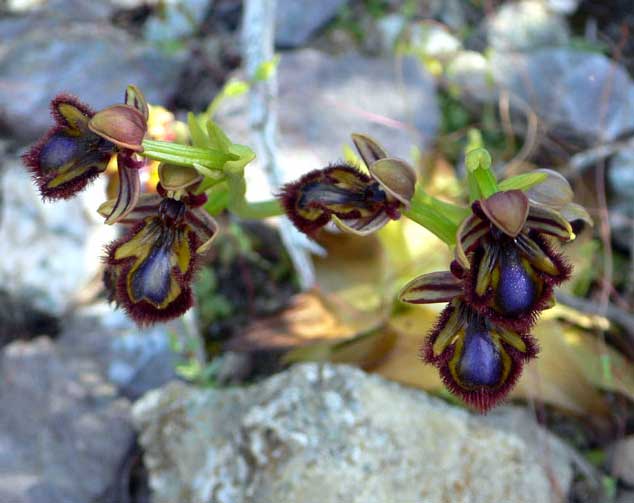
Ophrys speculum (*)
Classification System: APG IV
Superregnum: Eukaryota
Regnum: Plantae
Cladus: Angiosperms
Cladus: Monocots
Ordo: Asparagales
Familia: Orchidaceae
Subfamilia: Orchidoideae
Tribus: Orchideae
Subtribus: Orchidinae
Genus: Ophrys
Species: Ophrys speculum
Subspecies: (3) O. s. subsp. lusitanica – O. s. subsp. regis-ferdinandii – O. s. subsp. speculum
Name
Ophrys speculum Link, J. Bot. (Schrader) 1799(2): 324 (1800), nom. cons.
Typus: “Ophrys Speculum nb.” [Portugal, near Setubal], Link (B-W 16940-01 0, sub Ophrys scolopax) (typ. cons.)
Synonyms
Homotypic
Arachnites speculum (Link) Tod., Orchid. Sicul.: 93 (1842)
Homonyms
Ophrys speculum Bertol., Amoen. Ital.: 201 (1819), nom. illeg. - vide: Ophrys bertolonii Moretti, Quibus. Pl. Ital. 6: 9 (1823)
Ophrys speculum Steud., Nomencl. Bot., ed. 2, 2: 219 (1841), nom. inval. - vide: Ophrys lutea subsp. lutea
Distribution
Native distribution areas:
Europe
Southwestern Europe
Baleares, Corse, France, Portugal, Sardegna, Spain.
Southeastern Europe
Albania, Greece, Italy, Kriti, Sicilia, Turkey-in-Europe, Yugoslavia.
Africa
Northern Africa
Algeria, Libya, Morocco, Tunisia.
Asia-Temperate
Western Asia
East Aegean Islands, Lebanon-Syria, Turkey.
References: Brummitt, R.K. 2001. TDWG – World Geographical Scheme for Recording Plant Distributions, 2nd Edition
References
Primary references
Link, J.H.F. 1800. Journal für die Botanik 1799 (2): 324.
Additional references
Greuter, W. 2005 ("2004"). (1645) Proposal to conserve the name Ophrys speculum (Orchidaceae) with a conserved type. Taxon 53(4): 1071–1072. DOI: 10.2307/4135580 JSTOR Reference page. (accepted, vide Taxon 54: 1101. 2005 [2006]; Taxon 55: 800. 2006; Taxon 54: 1059. 2005)
Links
Emonocot.org 2018. Ophrys speculum in The Orders and Families of Monocotyledons. Published on the internet. Accessed: 2018 October 2.
Govaerts, R. et al. 2018. Ophrys speculum in World Checklist of Selected Plant Families. The Board of Trustees of the Royal Botanic Gardens, Kew. Published on the internet. Accessed: 2018 October 2. Reference page.
International Plant Names Index. 2018. Ophrys speculum. Published online. Accessed: 2 October 2018.
The Plant List 2013. Ophrys speculum in The Plant List Version 1.1. Published on the internet. Accessed: 2018 October 2.
Tropicos.org 2018. Ophrys speculum. Missouri Botanical Garden. Published on the internet. Accessed: 2018 October 2.
Vernacular names
català: Abellera de mirall
corsu: Ofride spichju
čeština: Tořič modropyský
Deutsch: Spiegel-Ragwurz
Ελληνικά: Οφρύς η κατοπτρική
English: Mirror orchid
español: Orquídea abeja espejo
français: Ophrys miroir
italiano: Ofride specchio
Ophrys speculum, the mirror orchid, is a species of Ophrys distributed throughout the Mediterranean that is pollinated exclusively by a single species of scoliid wasp.
Description
A terrestrial orchid up to 25 cm tall and each inflorescence carries between 2 and 8 large flowers. The plants often grow in groups. In bright sunshine the flowers are highly visible as the light reflects off the speculum in the centre of the lip – it is a bright iridescent purple/blue in colour and very glossy. The lip is three-lobed and bordered by a greenish-yellow border which is surrounded by a band of thick velvety hairs which are reddish brown. The sepals and petals are green and marked with violet spots or stripes.
Distribution
Ophrys speculum is spread throughout the Mediterranean region, and is particularly prolific in the Algarve region of Portugal. It becomes more scarce in the east. Other countries in Europe where this orchid is known to occur include Spain, Cyprus and Greece. It occurs up to 1,200 m above sea level.
Habitat
The mirror orchid is found in stony and rocky places, grassland, scrub and pine forests, on dry to moist calcareous soils, in full sunlight or light shade.
Pollination
It is pollinated exclusively by the wasp Dasyscolia ciliata. Males are lured by the flower, which resembles the female wasp. The flower and wasp are both hairy and the blue patch on the lip appears to mimic the reflection of the sky on the wasp's wings. Moreover, the floral scent resembles the mating pheromones of the female wasps, and males become highly excited and try to copulate with the flowers, pollinating them in the process.[1]
Varieties
Ophrys speculum subsp. speculum
Ophrys speculum subsp. regis-ferdinandii
Ophrys speculum subsp. lusitanica
Ophrys speculum subsp. speculum Link – The plant diffusion is circum-Mediterranean (Morocco and the Iberian Peninsula to Anatolia and Lebanon), characterized by dark petals and a lobe from the lip moderately convex, with marginal brownish hairs.
Ophrys speculum subsp. regis-ferdinandii – The plant is found in the eastern Aegean Islands at elevations of 0 to 800 meters. The fringes on the edge of the lip is light red and the side sections of the lip is dark green and less yellow.
Ophrys speculum subsp. lusitanica – The plant is found in the Algarve region of Portugal and the Extremadura region of Spain at elevations of 0 to 800 meters. The fringes on the edge of the lip is light red and the side sections of the lip is dark green and less yellow.
References
Ayasse M; Schiestl FP; Paulus HF; Ibarra F; Francke W (2003). "Pollinator attraction in a sexually deceptive orchid by means of unconventional chemicals". Proceedings. Biological Sciences. Proc. R. Entomol. Soc. 270 (1514): 517–522. doi:10.1098/rspb.2002.2271. PMC 1691269. PMID 12641907.
Henrik Aerenlund; Henrik Ærenlund Pedersen; Niels Faurholdt (2000). Ophrys: the bee orchids of Europe. Royal Botanic Gardens, Kew.
Retrieved from "http://en.wikipedia.org/"
All text is available under the terms of the GNU Free Documentation License

